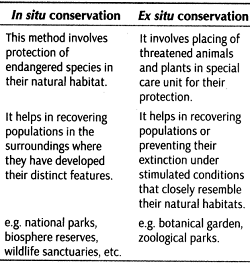

CBSE Class 12 Biology Notes Chapter 15: In Chapter 15 of the CBSE Class 12 Biology syllabus focuses on biodiversity and its crucial role in sustaining ecosystems and human life. Biodiversity encompasses the variety of living organisms, including species diversity, genetic diversity and ecosystem diversity.
By studying these notes students will gain a deeper understanding of the need for conservation efforts, both in situ (conservation of species in their natural habitats) and ex situ (conservation of species in controlled environments like zoos and botanical gardens). By going through these notes, students can strengthen their understanding of the chapter's concepts and learn more about Biodiversity and Conservation.CBSE Class 12 Biology Notes Chapter 15 Quick Revision Notes Overview
These notes are important for understanding the important concepts of biodiversity and conservation as they are prepared by subject experts from Physics Wallah. By studying these notes, students can learn about the serious problems of losing biodiversity and why we need to take action to conserve our environment.CBSE Class 12 Biology Notes Chapter 15 PDF
You can access the CBSE Class 12 Biology Notes for Chapter 15 Biodiversity and Conservation by clicking the link below. This PDF contains detailed explanations and key points that will help you understand the importance of biodiversity its different types and the conservation methods we can adopt to protect our planet. By reviewing these notes you will gain a clearer insight into the challenges facing biodiversity and the steps needed to ensure its preservation for future generations.Download CBSE Class 12 Biology Notes Chapter 15 Biodiversity and Conservation PDF
CBSE Class 12 Biology Notes Chapter 15 Biodiversity and Conservation
Below we have provided CBSE Class 12 Biology Notes Chapter 15 Biodiversity and Conservation-Introduction to Biodiversity
Biodiversity, or biological diversity, refers to the variety of ecosystems, species of organisms, and their variations such as biotypes, ecotypes and genes that are adapted to different climates and environments. This term was coined by Edward Wilson and encompasses the vast array of microorganisms, algae, fungi, plants, and animals found on Earth, whether in terrestrial or aquatic habitats. Biodiversity includes the ecological complexes to which these organisms belong and ranges from macromolecules to entire biomes.Levels of Biological Diversity
Biodiversity can be categorized into three main levels of biological organization:I. Genetic Diversity
Genetic diversity refers to the variation in genetic composition among individuals within a single species. For example, Rauwolfia vomitoria exhibits genetic variation in the concentration and potency of the chemical reserpine. India alone boasts more than 50,000 genetically different strains of rice and about 1,000 varieties of mango.II. Species Diversity
Species diversity refers to the variety of species within a specific region. An example of this is seen in the Western Ghats, which has a higher diversity of amphibian species compared to the Eastern Ghats.III. Ecological Diversity
Ecological diversity encompasses the different types of ecosystems present in the environment. This includes deserts, rainforests, mangroves, coral reefs, wetlands, estuaries and alpine meadows.Importance of Biodiversity and Conservation
Biodiversity and its conservation are crucial environmental issues that have gained international attention. As awareness of the importance of biodiversity for survival and well-being increases, more people recognize its significance on our planet.- According to the International Union for Conservation of Nature (IUCN), approximately 1.5 million plant and animal species have been described so far, but many more species remain to be discovered and described.
- Of the recorded species, over 70% are animals, while the remainder consists of plants, including algae, fungi, bryophytes, gymnosperms, and angiosperms. Among animals, insects make up about 70% of the total species count.
- The number of fungi species in the world exceeds the combined total of fish, amphibians, reptiles and mammals.
Biodiversity in India
India stands out as one of the twelve mega biodiversity countries in the world. Despite covering only 2.4% of the global land area, India is home to approximately 8.1% of the world's species biodiversity. The country boasts about 45,000 species of plants and between 90,000 and 100,000 species of animals. However, many new species remain to be discovered and named. According to Robert May’s global estimate, only 22% of total species have been recorded, indicating that India likely has more than 100,000 species of plants and around 300,000 species of animals yet to be discovered and described.Patterns of Biodiversity
a) Latitudinal Gradients
The diversity of plants and animals is not uniform across the globe; it shows an uneven distribution along latitudinal gradients. Species diversity decreases as we move from the equator towards the poles. Tropical regions, such as the Amazonian Rainforest, harbor a greater variety of species than temperate or polar areas. The Amazon Rainforest alone is home to more than 40,000 species of plants, 125,000 species of insects, 300 species of fish, 427 species of amphibians, 378 species of reptiles, 1,300 species of birds and 427 species of mammals. Several hypotheses explain this biodiversity pattern:- Time and Speciation : Unlike temperate regions, which have experienced frequent glaciations, tropical latitudes have remained relatively undisturbed for millions of years, providing a long evolutionary time frame for species diversification.
- Environmental Stability : Tropical environments are less seasonal and more constant than temperate ones, promoting niche specialization and resulting in greater species diversity.
- Solar Energy : The tropics receive more solar energy, which contributes to higher productivity and indirectly supports greater diversity.
b) Species-Area Relationships
Alexander Von Humboldt noted that within a region, species richness increases with the explored area, but only to a certain limit. The relationship between species richness and area for various taxa, such as angiospermic plants, freshwater fishes and birds, is represented as a rectangular hyperbola. On a logarithmic scale, this relationship is expressed by the equation: On logarithmic scale, the relationship is a straight line described by the equation-
log S = log C + Z log A.
Where, S= species, A= Area, Z= slope of the line, C =Y- intercept.
On logarithmic scale, the relationship is a straight line described by the equation-
log S = log C + Z log A.
Where, S= species, A= Area, Z= slope of the line, C =Y- intercept.
- Ecologists have discovered that the value of Z lies in range of 0.1 to 0.2 regardless of taxonomic group of the region.
- In very large area like continents, Z value ranges between 0.6 & 1.2.
The Importance of Species Diversity to the Ecosystem
Species diversity plays a critical role in maintaining the stability and health of ecosystems. Communities with a greater number of species tend to be more stable than those with fewer species. A stable ecosystem is characterized by minimal fluctuations in productivity from year to year, which is essential for sustaining both natural environments and human life. Rich biodiversity is vital for ecosystem health and is imperative for the survival of the human race on this planet. One of the key concepts illustrating the significance of species diversity is the Rivet Popper Hypothesis , proposed by Paul Ehrlich. This hypothesis compares an ecosystem to an airplane, where all parts are held together by thousands of rivets (species). If passengers (species) start popping rivets (causing extinctions) to take home, the airplane may continue to function initially without immediate danger. However, as more rivets are removed, the plane becomes increasingly weak over time. Moreover, the removal of specific rivets can have varying consequences: losing rivets from critical areas, like the wings (key species essential for major ecosystem functions), poses a greater threat to flight safety than removing rivets from less critical areas.Loss of Biodiversity
Unfortunately, the biological wealth of our planet has been declining rapidly due to three primary factors: population growth, urbanization, and industrialization. According to the IUCN Red List (2004) , 784 species have gone extinct over the last 500 years, including 338 vertebrates, 359 invertebrates, and 87 plant species. Notable recent extinctions include the dodo from Mauritius, the quagga from Africa, the thylacine from Australia, and Steller’s sea cow from Russia. Additionally, three subspecies of tigers (Bali, Javan, and Caspian) have also vanished. In the past 20 years alone, 27 species have disappeared. The loss of biodiversity in a region can have several detrimental effects:- Decline in Plant Production : Fewer species can lead to reduced overall productivity, impacting food supply and ecosystem function.
- Lowered Resistance to Environmental Changes : Ecosystems with less diversity are more vulnerable to disturbances such as droughts and floods, making them less resilient to change.
- Increased Variability in Ecosystem Processes : A decline in species diversity can lead to unpredictable fluctuations in processes such as productivity, water usage and pest and disease cycles, ultimately threatening ecosystem stability.
CBSE Class 12 Biology Notes Chapter 15 FAQs
What is biodiversity?
Biodiversity refers to the variety of life on Earth, including different species of plants, animals, microorganisms and their genetic diversity.
Why is biodiversity important?
Biodiversity is crucial for ecosystem health, providing essential services such as clean air and water, pollination of crops, climate regulation and nutrient cycling.
What are the major threats to biodiversity?
Major threats include habitat loss and fragmentation, over-exploitation of resources, pollution, climate change and invasive species. These factors contribute to the decline of species and ecosystems.
What is the concept of biodiversity hotspots?
Biodiversity hotspots are regions with a high number of endemic species that are experiencing significant habitat loss. There are 34 recognized biodiversity hotspots globally, which are prioritized for conservation efforts.
🔥 Trending Blogs
Talk to a counsellorHave doubts? Our support team will be happy to assist you!

Check out these Related Articles
Free Learning Resources
PW Books
Notes (Class 10-12)
PW Study Materials
Notes (Class 6-9)
Ncert Solutions
Govt Exams
Class 6th to 12th Online Courses
Govt Job Exams Courses
UPSC Coaching
Defence Exam Coaching
Gate Exam Coaching
Other Exams
Know about Physics Wallah
Physics Wallah is an Indian edtech platform that provides accessible & comprehensive learning experiences to students from Class 6th to postgraduate level. We also provide extensive NCERT solutions, sample paper, NEET, JEE Mains, BITSAT previous year papers & more such resources to students. Physics Wallah also caters to over 3.5 million registered students and over 78 lakh+ Youtube subscribers with 4.8 rating on its app.
We Stand Out because
We provide students with intensive courses with India’s qualified & experienced faculties & mentors. PW strives to make the learning experience comprehensive and accessible for students of all sections of society. We believe in empowering every single student who couldn't dream of a good career in engineering and medical field earlier.
Our Key Focus Areas
Physics Wallah's main focus is to make the learning experience as economical as possible for all students. With our affordable courses like Lakshya, Udaan and Arjuna and many others, we have been able to provide a platform for lakhs of aspirants. From providing Chemistry, Maths, Physics formula to giving e-books of eminent authors like RD Sharma, RS Aggarwal and Lakhmir Singh, PW focuses on every single student's need for preparation.
What Makes Us Different
Physics Wallah strives to develop a comprehensive pedagogical structure for students, where they get a state-of-the-art learning experience with study material and resources. Apart from catering students preparing for JEE Mains and NEET, PW also provides study material for each state board like Uttar Pradesh, Bihar, and others
Copyright © 2025 Physicswallah Limited All rights reserved.












